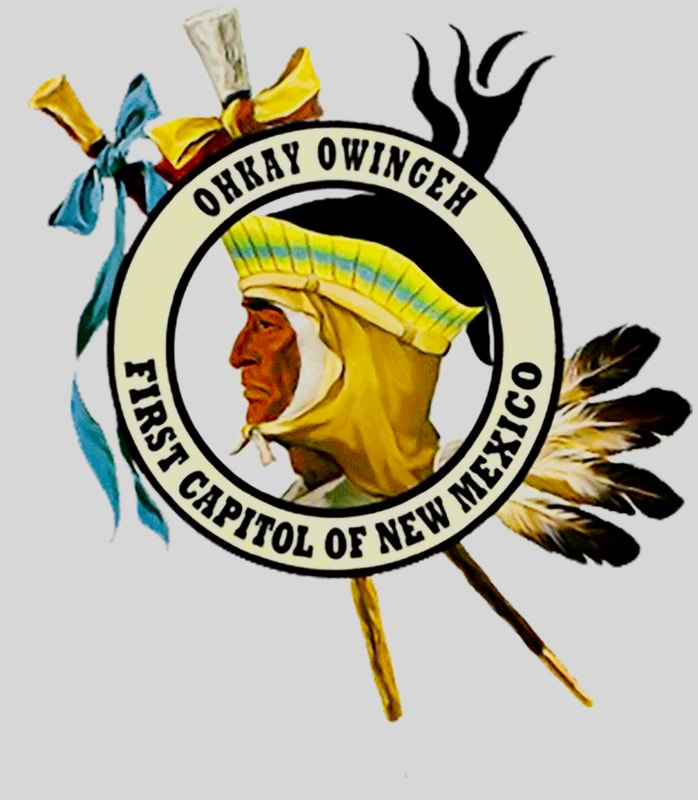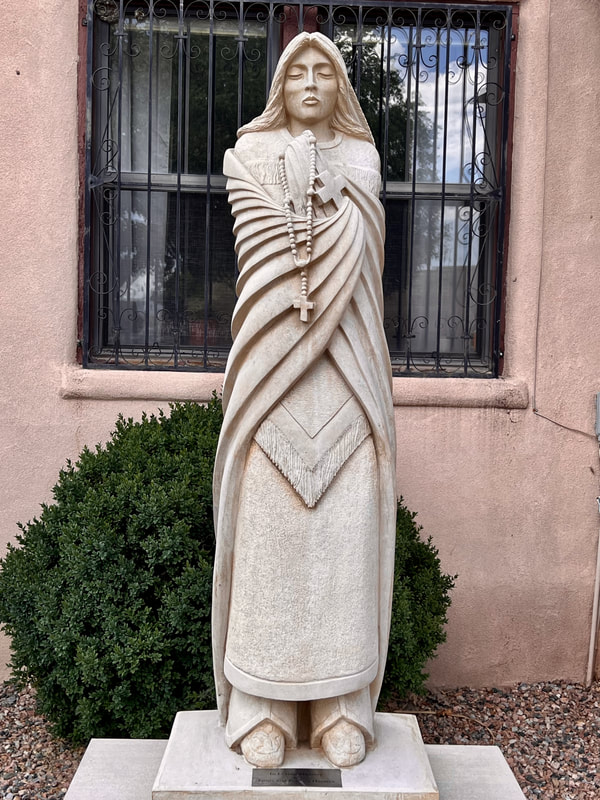EXPLORING
|
|
|
By Miguel Pérez
Part 23 of a series It was the first colonial capital of the Spanish province of Nuevo Mexico — San Juan de los Caballeros — the village founded by the Spanish settlers in the Juan de Oñate expedition at the end of their 750-mile journey from central Mexico in 1598.
But if you do a Google search for "San Juan de los Caballeros" nowadays, you are likely to also find "Ohkay Owingeh." Since 2005, the town has returned to its pre-Spanish roots. Yet, perhaps because the name-change is still recent, you feel like you have found a town with an identity crisis. All over the internet, you will either find "Ohkay Owingeh Pueblo, formerly known as San Juan Pueblo" or "San Juan de los Caballeros, now known as Ohkay Owingeh." |
|
The same thing happens when you talk to the people here. They are mostly Tewa Native Americans. Yet, some tell you they live in Ohkay Owingeh and others tell you they live in San Juan. Some use both names interchangeably. Until now, when people told me they were from San Juan, I knew exactly what they meant. I love Puerto Rico! LOL But this is different.
When you drive into Ohkay Owingeh, traces of San Juan are hard to find. Old Spanish landmarks are mostly gone. You know you are in Ohkay Owingeh from the signs on commercial establishments, especially from the marquee and billboards promoting the town-owned Ohkay Casino. That's when you know you are in Indian territory. Some background: Ohkay Owingeh, meaning "place of the strong people," has been occupied by Tewa-speaking natives since they migrated south from what is now the San Luis Valley of Colorado around 1200 A.D. |
|
|
It is now a federally recognized tribe of about 1,200 people in Rio Arriba County, four miles north of Española and some 25 miles north of Santa Fe. It is the historical meeting place for Native American leaders and still serves as the headquarters of the Eight Northern Pueblo Tribal Council. The town also hosts the One Oweenge Crafts Cooperative, showcasing pottery, weaving and artwork from the eight northern pueblos.
When Spanish settlers arrived, they reportedly appeared to start a peaceful relationship with natives who were very hospitable. They traded goods and were offered temporary shelter. Eventually, the natives ceeded an area about a mile away (on the other side of the Rio Grande) where the Spanish could settle permanently. Both sides apparently had good intentions for establishing friendly relations. |
|
But the good relations did not last. It is said that Oñate ordered his men to amputate a foot from at least two dozen natives in another village, Acoma Pueblo, and that he was retaliating for several Spanish soldiers who were killed by the natives, including his nephew.
Deeper background: Oñate was a wealthy Spanish citizen born in 1550 in Zacatecas, New Spain (Mexico). “Because of his wealth and influence, he was able to win the bid for the contract with the Spanish government to colonize present day New Mexico," according to an exhibit at the Bond Museum in nearby Española. "In return for his investment, Oñate was named both governor and captain general, which gave him civil and military authority over the colony." |
|
While history books and museums sometimes differ on the numbers to describe the size of the Oñate expedition, the Bond Museum explains that the lengthy caravan "included about 400 people, half being civilian men and women, an unstated number of servants and slaves, 129 soldiers of the Spanish king, 10 Franciscan friars (8 priests 2 lay brothers). Eighty-three carretas or ox drawn carts carried their necessities: food, clothing, kitchenware, medicine, mining and blacksmithing tools, armaments, and trade goods. The caravan brought over 7000 head of livestock: horses, cattle, sheep, and goats. Oñate also brought trees, chile seeds, corn, and barley.” It was enough to change the American West forever!
At the nearby Mission Museum, also at the Plaza of Española, you learn that, "A large caravan assembled at Compostela, Mexico in January, 1598" and that, "they advanced slowly toward the Rio Grande, stopping at Indian settlements along the way and celebrating a day of Thanksgiving at present day El Paso del Norte in April 1598." |
Slideshow below, from part one of this series: Albuquerque's "La Jornada" statuary, depicting the first Spanish settlers, although the statue of their leader, Oñate, has been removed. Photos: Miguel Pérez
|
|
After crossing the Rio Grande in the part that now separates Mexico from the United States, they followed the river as it turns north and cuts across New Mexico. Mind you, that was nine years before the British settled in Jamestown, Va. in 1607.
"On July 11 1598, a scouting party arrived at the Tewa village of Ohkay Owingeh, located at the confluence of the Rio Grande and the Rio Chama," says the Mission Museum. "Here the expedition stopped, renamed the village San Juan de Los Caballeros and thus Oñate and his companions established the first Spanish capital in New Mexico." Named after St. John the Baptist and in recognition of the hospitality they first received from Native American caballeros (knights), San Juan de los Caballeros also became the northernmost colony in the Spanish empire! On the internet, there are also discrepancies about whether San Juan de los Caballeros was actually New Mexico's first colonial capital. Since Oñate relocated the village to the west side of the Rio Grande only a few months after arriving, to a new village he named San Gabriel, some internet articles say San Gabriel is the first capital while others called it the second. Confusing? Yes! But regardless of its name and whether it was the fist capital, nothing can diminish the historical significance of this place! There is so much history here, and much of it is so controversial, that I'll have to come back to examine some of it in more detail. After all, this is the place where a bronze statue of Oñate had a foot amputated in 1998, an obvious retaliation for Oñate's most notorious act of cruelty. This is the place where that statue was removed from public viewing (by county officials) in June of 2020 to prevent it from being vandalized by protesters, and where efforts to erect it at another county property in 2023 resulted in the shooting of an anti-Oñate protester. |
|
|
This is also the birthplace of Po' Pay, the Tewa leader who led the 1680 Pueblo Revolt that killed some 400 Spanish settlers and 21 missionaries, drove thousands of others out of New Mexico, and called on his people to eradicate Spanish language, customs, and beliefs from their lives.
Both Oñate and Po' Pay were extremely violent, responsible for many deaths and much hardship. Yet, while Oñate's statues are being removed from public view nowadays, Po' Pay's statue represents New Mexico in the statuary hall of the U.S. Capitol. (See photo). When I went looking for the Oñate Monument Center, in nearby Alcalde, and the impressive Oñate equestrian statue that once stood there, all I found was a concrete pedestal, with a bronze plaque still recognizing "Don Juan de Oñate, captain general and first governor of New Mexico 1598-1610." Not only was the statue removed, but the center was also closed and the building was abandoned. (See photos). |
|
|
Efforts to bring the statue out of hiding and erect it at another location have been met with pro and con demonstrations between those who still see Oñate as a great colonizer and those who see him as a cruel invader.
Unfortunately, some wars never end. And this one, still fighting over monuments, has passionate warriors on both sides. But fortunately, Hispanics are not known for desecrating Native American monuments. I would find it embarrassing! When I found a statue of Po' Pay at the Indian Pueblo Cultural Center in Albuquerque, I took a selfie with him! Why? Because I don't fight centuries-old wars! Because it is foolish, and cowardly, to fight against immobile objects that cannot fight back. Because history is history. We have to accept it and live with it, even when it hurts! What we cannot do is hide it! |
|
But let me tell you what I found when I went looking for traces of San Juan de los Caballeros in Ohkay Owingeh. As you drive across the town, heading northwest on Po' Pay Avenue, you arrive at a point where you find two catholic churches, one on each side of the road. On one side is the San Juan Bautista and Tewa Missions Catholic Church, and across the street stands the Shrine of Our Lady of Lourdes.
The shrine was built in 1890 in response to the 1858 apparitions of the Virgin Mary in Lourdes, France. But the San Juan Bautista parish is a direct descendant of San Miguel Mission and several (no longer standing) adobe churches built near here by the Spanish settlers who came with Oñate since 1598. It began as San Juan Bautista at its current location in 1643, and it was destroyed by Native Americans during the Pueblo Revolt of 1680. It was rebuilt again in 1706 and 1913. |
|
|
Although rebuilt in French Gothic style, the current stone and brick church is by far the most visible trace of San Juan Pueblo and Spanish presence here. It is also a vivid demonstration of deeply held Catholic faith by today's Tewa natives. In this church, the choirs sing in Tewa, Spanish, English and Gregorian chants.
At the entrance of San Juan Bautista, parishioners are greeted by statues of the Our Lady of Lourdes and Saint Kateri Tekakwitha (1656-1680), the first Indian in North America to be canonized (in 2012). She was an Algonquian-Mohawk from present-day New York State. There is a San Juan Elementary School and in Google Maps, the whole area is also called the "San Juan Indian Reservation." Yet over the years, while Ohkay Owingeh has shed much of its Spanish heritage, the City of Española, four miles to the south, has been enriched by Hispanic culture. Even the Spanish history of Ohkay Owingeh is on display in Española museums! |
|
That's where you learn that a few months after establishing San Juan de los Caballeros on the east side of the Rio Grande, Oñate came to an agreement with the natives and moved the Spanish settlers to the other side of the river, to an old Tewa village called Yunque, and established a new settlement he called San Gabriel del Yunque. "San Gabriel served as the official capital of New Mexico until 1609-1610, when the Village of Santa Fe was established as the official seat of Spanish government,” says the Mission Museum.
But if San Gabriel was the capital of New Mexico for more than a decade before it was moved to Santa Fe, what happened to it? Why can't we find San Gabriel on the map? |
To read other parts of this ongoing series, click: EXPLORING NEW MEXICO





















